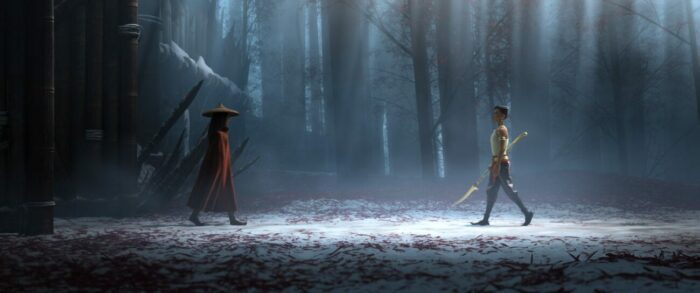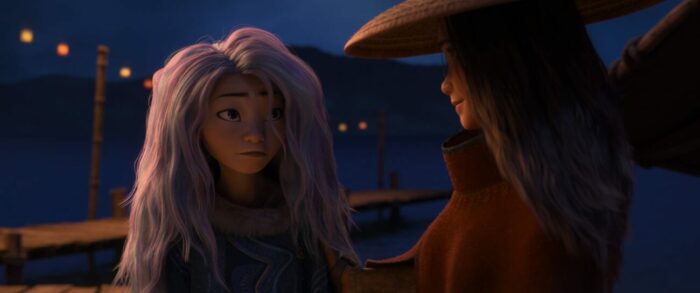Seeing Disney’s Raya in the Last Dragon calls to mind a fundamental principle of fiction outlined by famed graphic novel storyteller Neil Gaiman in a session of his MasterClass course. He says there’s “truth in fiction.” To him, “one of the central tools of literature is using the ‘lie’ of a made-up story to tell a human truth.” Speaking on the vitality of creating memorable stories with their deliberate takeaways, Gaiman doubles-down to add:
What we’re saying is we are using lies. We’re using memorable lies. We are taking people who do not exist and things that did not happen to those people in places that aren’t, and we are using those things to communicate true things to kids.
That is beautifully blunt, and undeniably correct, wisdom from Gaiman. That’s everything from the wildest fairy tales to most present realistic fiction of the given era. To be specific to the film at hand, that’s damn never every Disney classic too. But the “lies” work because memorable stories dazzle and impress eyes and hearts at the same time. Nestled in a completely foreign realm of magic and myth, the real-life parallels woven into the high fantasy of Disney’s Raya and the Last Dragon couldn’t ring louder or truer if it stole every bell in the record-holding Christ Church Cathedral in Dublin. The movie debuts on Disney+ and in theaters on March 5th.
Raya and the Last Dragon divulges the tumultuous history of the splintered land of Kumandra. Five centuries earlier, the unified magic of powerful guardian dragons extinguished the amassed destruction brought on by rolling, smoky Druuns, a horde of all-consuming miniature plagues that turned the people they enveloped into stone. It cost all the dragons their lives, save one, a dormant legend named Sisu. All that remained was a gem of their residual magic now protected by the royal family bloodline that leads the land of Heart.

Heart’s success and perceived favor, currently stewarded by Chief Benja (TV star Daniel Dae Kim), has led the other neighboring regions to madly covet and constantly target Heart to steal that precious jewel. Benja has recently anointed his spirited daughter Raya as the next projector while he seeks diplomacy with the other tribes to unite Kumandra again. When that peace offering event is exploited with betrayal and ruined by the return of the Druuns, the gem is broken and its divided parts are confiscated by the other ruling powers.
Six years pass and the now-adult warrior Raya (Star Wars cast member Kelly Marie Tran) seeks to summon Sisu and reconstruct the absconded shards to purge the Druuns once more. What she finds is the quirky dragon embodied by comedienne Awkwafina (The Farewell) that isn’t the most immediate paragon hero. Raya also acquires a growing rabble of converted helpers and merry followers while dodging the adversarial pursuits of Namaari (Gemma Chan of Crazy Rich Asians), a fellow warrior princess with not all that dissimilar aims to her own.

The warring geographic opponents of Raya and the Last Dragon are tormented with lacking trust. They’ve either witnessed betrayal, perpetrated it, or been sold it by generational strife. Too many of them are done trying to give trust to get trust despite when cooperation is so clearly their best chance at survival. One mantra coming out of the film from the writing team of Crazy Rich Asians screenwriter Adele Lim and Vietnamese-American playwright Qui Nguyen is to “stop, learn, and trust.” If ending the confrontational natures wasn’t hard enough, gaining the empathetic and educational angle is even more difficult, yet still essential.
The dragons and all the surrounding magic can count as deities and miracles within Raya and the Last Dragon, but, as Gaiman’s above statements would support, the true empowerment of sustained life and community comes from people. The support and success that comes from unified hope and actions of people coming together is second to none. That’s when humanity, even a fictionalized one, believing in each other is at its best.
In both strength and weakness, Nguyen and Lim lay the trust talk on mighty thick. That totem is a rightly appropriate one to convey, but great parables are richer and deeper when they can offer more than one adage. The complementary threads of parents and their heirs, broken friendships, and selflessness are weaker in expression than that big narrative cable of trust. Add the chatterbox blend of modern vernacular and humor spun by Awkwafina as the persona who harps the most about trust and Raya and the Last Dragon can come across as slightly too effusive. Luckily, she’s a hoot and doesn’t reach anywhere close to Eddie Murphy territory.

What shores up the thematic exuberance is the virtuous pride taken in the movie’s creation. The directing duo of Big Hero 6 Oscar winner Don Hall and Blindspotting director Carlos Lopez Estrada and the massive team of department contributors behind Head of Story Fawn Veerasunthorn (Ralph Breaks the Internet) have saturated this animated film in glorious artistic finery fit for the biggest and loudest silver screen. Swelled by a strong score from composer James Newton Howard (his first Disney work in 18 years), the elemental styles of Raya and the Last Dragon borrow gratifying and opulent inspiration from the nations of Southeast Asia. No compass or map can take you to a Kumandra on this Earth, but that doesn’t matter. The fantastical is right here to enjoy.
Folks are justified in celebrating the cultural representation that Raya and the Last Dragon redeems. It is a dignifying bonus to the “magic of fiction” presented again by Neil Gaiman in that MasterClass. Applying Gaiman to this movie, Raya and the Last Dragon matches his notion of fiction “giving you something big and true and important that you might not otherwise get. And you can carry it in your heart, and you can tell it to your children and your children’s children.” That’s the kind of effect received here and felt no matter your demographic.



